#combat focus is transparently the best ability in this game
Text
prey is so funny. yes one of my completely ordinary and normal human abilities is to move at 300% speed while being totally unable to tire
#prey 2017#combat focus is transparently the best ability in this game#ha ha hee hee i dont need any alien superpowers i can just sprint at mach fuck across the station#oh theres a nightmare here? bye im literally already two full sectors away#whats that you say? i HAVE to kill the nightmare? ok lemme use this shotgun like a fucking machine gun while it can't move#and also like actual stealth purposes - you moving faster than the detection meter can register you is very handy#its like bend time in dishonored just so easily the best power#give me a time stop and ill give you up to 8 corpses and an unexplainable burglary
28 notes
·
View notes
Text
Introduction to the OSR
what's an OSR? it's a game that's kinda like old-school D&D. or is old-school D&D. or is compatible with old-school D&D. an OSR game generally has some or all of the following principles:
low character power with highly lethal combat. in old-school D&D a 1st-level fighter has d8 hit points and a longsword does d8 damage, and you die at 0HP. this is not to ensure characters die all the time but to emphasize the next bullet point:
emphasis on creative problem solving. most situations cannot be solved by straightforward use of your abilities (such as charging into every situation with swords drawn, if a fighter), so the game tests lateral, outside-the-box thinking.
emphasis on diegetic progression. spells are found, not obtained automatically on level-up. you get XP by finding gold more than killing monsters. most of your cool abilities come from magic items. making alliances & hiring followers is encouraged.
focus on managing inventory, resources, risk, and time. the players are constantly faced with meaningful decisions; this is the heart of the game.
very sandbox-oriented. the focus on creative problem solving means the game must be accommodating to players taking a course of action the GM didn't plan for. use lots of random tables to generate emergent story. some elements of new simulationism.
high tactical transparency, i.e., the optimal course of action is rarely system-specific, and ideally very possible for a new player to intuit.
usually semi-compatible with old D&D, but not always. usually rules-lite, but not always.
what does the OSR mostly NOT do?
focus on character builds. these change the focus too much to be on the rules than the fiction, can create situations where stuff everyone should be able to do is an ability locked to one class, and impede tactical transparency.
resolve everything with a die roll. combat uses dice to be scary, unpredictable and most importantly not your default course of action. everything else should bring up dice rarely - dice are your plan B when your plan A fails. the best plans need no dice.
use linear storytelling or put players into a writer/GM role. linear storytelling gets in the way of the decision-making so core to the playstyle; letting players write details into the setting is mutually exclusive with them discovering it.
rules for everything. 400 pages of crunch is worse at simulating a believable world than the GM and players' shared understanding. OSR games rely constantly on GM ruling.
mostly still applies to all the above. making your system a "pure" OSR game comes second to doing what's best for your game.
System recommendations
old D&D or a retroclone
old-school D&D - or old school essentials or basic fantasy or swords & wizardry, which are old D&D's mechanics repackaged with quality-of-life tweaks (and the upside of not giving WOTC your money) - are usually the go-to when recommending someone's first OSR game. they're actually not my first pick, though!
PROS:
very complete, with more robust rules than a lot of the lighter games on this list.
100% compatibility: most OSR adventures are statted for old school essentials. converting them to other OSR systems is usually simple, but not 1-for-1.
easier to find games for. anyone interested in the OSR space knows what old school essentials is.
CONS:
jank. these games largely still have weird saves, level limits for non-humans, some still have descending AC, etc etc. it's not that bad but it is there
i hate thief skills. lots of essential dungeoneering actions are locked to the thief class as abilities, with abysmally low success chances. this is stuff i prefer being handled without a roll. thieves in this system suck and make everyone else worse at dungeon crawling by existing.
there's just lots of really cool shit in other systems i'm about to go into that you just don't get here
Knave 1e and its various hacks
this is a 7-page super-lightweight system that boils everything down to just the essentials.
rolling a character takes like 5 minutes. roll stats, roll gear, roll traits, go. done. it's great.
characters are defined entirely by stats and gear, no classes. wanna be a fighter, have high strength and carry a big sword and armor. wanna be a wizard, have high intelligence and fill your inventory with spells. item slots are elegant and pretty limited.
initiative is instant: roll d6. 1-3, monsters go first. 4-6, PCs go first. swingy, but god it is so smooth and shaves like the most boring 5 minutes off of every combat
monsters are so very elegant. old D&D gives monsters a "hit dice" rating to determine their HP, e.g. a 3HD monster rolls 3d8 for hit points. knave takes this number (HD) and uses it for attack rolls and saves (aside from exceptionally bad/good saves), so a knave statblock looks something like this.
spells are all one or two sentences long & extremely easy to remember.
7 pages is so light. i have the system basically memorized.
DOWNSIDES: there's no dungeon crawling rules (standard for meatier OSR games & something i consider essential) and no real bestiary, though the second point isn't a huge deal cause they're so easy to make. it also kinda assumes you already know how to run OSR games, so there's very little real advice or guidance.
KNAVE HACKS
knave 1e is in creative commons & comes with an editable word doc for you to publish with modifications, so there's a ton of variants (there was a spreadsheet of them somewhere, but i can't find it).
Grave is a favorite - i'm two years into a grave campaign and it's fantastic. it's a dark-souls-y version of knave with some really elegant innovations.
you have a set number of deaths before you for-reals die, as every character plays an undead as is dark souls tradition. makes it good for OSR beginners! being able to tell when you're close to your final death is really good - it lets you emotionally prepare for losing your character & raises the stakes more the more you die. (though honestly you should probably cut the number of extra deaths in half, it's super generous)
XP and gold are combined into one resource, souls. legendary creatures drop big souls you can make into magic items. this has ended up being the coolest thing in my current campaign. my players love finding powerful souls to make into magic items it's so fun
uses preset packages of stats/gear instead of knave's rolled ones, filling the role of more traditional character classes. has the wonderful side effect of not making you get stuck with low stats cause you rolled bad one time.
you have stamina equal to your empty item slots. you spend stamina on spells if you're a caster, or free maneuvers (on top of your attack at no action cost) if you're not. it's super elegant.
there's 3 classes of spells: wizardry for intelligence, holy magic for wisdom, and witch stuff for charisma. nice and intuitive.
there's a page of 50 magic items each a couple sentences long. this PDF is worth it just for the magic items.
DOWNSIDE: see the downsides for knave 1e. all still apply.
i enjoyed grave so much i made a variant of it with the dark souls bits removed (and some dungeon crawl rules added!) to use for my standard fantasy campaigns.
Knave 2e
sadly knave 2e is not purchasable yet (i backed it on kickstarter so i have access, though). but when it comes out i highly recommend it.
much larger and denser than knave 1e. it finally has dungeon crawling rules, it has GM and player guidance, everything is refined and the layout is so so nice and readable.
combat is a bit more interesting than 1e. you can break your weapon against an enemy to deal max damage. you get a free maneuver on high attack rolls.
there's rules for stuff like alchemy, warfare, building a base. it all kicks ass.
there are so many goddamn tables. i rifle through it anytime i need inspiration.
DOWNSIDES: i personally can't think of any! it's a very complete good functional system.
Mausritter
you play tiny little mice! in a world full of big dangerous things that want to eat mice. cat = dragon. you get it. what more could you want
the mouse thing is just super intuitive. you get the dynamic between you and the big scary lethal world. fantastic OSR game to introduce kids
nice and robust ruleset; nothing feels missing
tons of super nice GM stuff! faction rules, tools for rolling up hexcrawls and dungeons, plenty of tables
super clean readable layout. font isn't too small to avoid being intimidating. guidance is really nice and clear.
combat is autohit. super fast & lethal.
100% free
look mausritter is just. good. i wanna run it so bad someday
Worlds Without Number
sort of a middle ground between OSR stuff and 5e.
lots of classes, at least in the paid version. the free version comes with just the warrior, expert and mage. there's feats and more of a focus on builds than most OSR games. if you like more mechanical build variety than a typical OSR game, this is a great game for you!
extremely good multiclassing. y'know how in most games if you just mash together two classes you think are cool you'll end up with a total mess? not here! every combo is viable and works fine! easily the best multiclassing of any game i've touched
an absurd amount of GM stuff and tables. easily more than any of the other stuff i've praised for also having them. but personally i haven't dug into them as much, so i can't really comment on them
skills the way modern D&D has them. you roll dice and try to beat a target number. i don't tend to like rolled skills, but most people do, so if that's your thing WWN has them
DOWNSIDES
the layout is terrible. everything is a huge wall of text with very little use of bold text or bullet points to draw attention to the important bits. the table of contents has like 15 things in it for a 400-page book! i couldn't find any of the paid-version-exclusive classes for like a month after i bought it! looking up rules is a nightmare.
the way the default setting handles "evil races" is like an exaggerated parody of all the problematic aspects of how D&D handles it. like, it wants so bad for you to have an excuse to genocide sentient free-willed people. but at least the default setting is easy to chuck in the trash
Dungeon Crawl Classics
the goal of this system is to take all of the crazy gonzo moments people remember playing old-school D&D in their childhood and turn all of that up to 11 while cutting the stuff that doesn't add to that. i think a lot of its innovations have ended up kind of standard in newer OSR stuff (like fighters getting maneuvers with their attacks), but it still has more to offer.
the funnel: you start the game with four randomly rolled dipshit peasants that you then throw into a meatgrinder to get horribly killed. you pick one of the survivors to be your 1st-level character.
maneuvers: fighters roll an extra die with each attack that gets bigger as you level. if it's a 3 or higher, you get to do a cool thing on top of your attack. pretty standard for OSR games, but this game popularized it!
crit tables: fighters also get more crits and nastier crits as they level. every crit, you roll on the crit table. maybe you chop off a dude's arm. maybe you just knock them over. maybe you shatter their shield. it's very cool
spell tables: i don't really like roll-to-cast mechanics, generally. but DCC goes so all-in on roll-to-cast that it still looks fun as hell to watch. you cast a fireball and maybe it goes how you want. or maybe you explode, or you nuke everything in a half-mile radius, or from now on you permanently ignite flammable materials you touch, or whatever. casters just have to put up with turning into a weird mutated mess across a campaign
there's no dungeon crawl rules, no encumbrance - this game is all about the big over-the-top wacky shit, and is not really interested in the more down-to-earth number crunching. it's more in the you-die-hilariously-all-the-time area of OSR than the you-avoid-death-through-clever-play area. not really my thing but the system knows exactly what it wants to be and i respect it
iron halberd
this one is mine! as the author i'm not qualified to tell you what isn't good about my system, so just assume it's worse than i make it sound, but here's a bunch of the selling points
semi-random character creation where you flip back and forth between rolling dice and getting your own input. roll stats, pick ancestry. pick starting gear kit, roll different dice based on which kit you picked. etc etc. stats are random but all equally viable (no rolling incredibly low or high stats). every time i run this game the character creation is a hit. seriously go roll up a character it'll sell you on the whole thing
you start out a lot stronger than a standard OSR character but grow way more slowly. i don't like 4th-level characters being 4 times as strong as 1st-level ones; HP never gets that high. emphasis is more on diegetic progression instead.
way too many subsystems for alchemy, crafting, strongholds, warfare, renown, rituals, likes 9 pages of magic items, a whole subsystem for becoming a cleric mid-campaign. i couldn't help myself i love this shit
in my current campaign we had a player permanently sacrifice some max HP to become a necromancer after deliberating on whether that's a good idea for like thirty seconds, which instantly made me think my necromancy system is a success
also free
Adventure recommendations
(in rough order of size)
Moonhill Garden (by Emiel Boven): look at this. look at it! this is like the best template for a little dungeon in an OSR game. all of the little factions are tied together. this would be a great oneshot to introduce people to an OSR system with.
A gathering of blades (by Ben Milton): a system-neutral, one-page sandbox. i ran this for an iron halberd game and it went super well. lasted like 7 sessions. highly recommend.
The Waking of Willowby Hall (by Ben Milton): a single dungeon with a million things going on. it's super chaotic with half a dozen different factions crashing into each other and a big angry goose. highly recommend, especially for kids
The Black Wyrm of Brandonsford (by Chance Dudinack): small sandbox with a fun fairytale vibe and a very fleshed-out little town. and a big nasty dragon.
Evils of Illmire (by Zack Wolf): this is a very dense, entire campaign's worth of hexcrawl in a very compact package for like $5. it doesn't do anything particularly new, but the value-for-money is absurd and it's a really good template for how to do a sandbox if you're used to 5e adventures
Ask me anything!
if anything here is unclear or intrigues you, send me asks! i love helping people get into OSR games. i'll link frequently asked questions here if i get any.
#osr#nsr#ttrpg#d&d#iron halberd#knave#worlds without number#dungeon crawl classics#mausritter#l2j archive
312 notes
·
View notes
Note
arcane archer anon here. I'm in a party of 3 with a paladin and mercy monk. I'm mostly looking for buffs as I'm in the back row and tend not to get hit as much; and we've had a few close calls that made me want to get emergency healing so we can all pick each other up in a fight. my charisma is decent at 13 but I didn't even consider bard or warlock until now. so I'd appreciate your suggestions! I want to eventually get to level 5 fighter but spending 2+ levels on something else is fine by me.
So. To be totally transparent this is a kind of rough party build; you all chose martial classes for a three-person party and that requires really careful DM-ing to balance out well, and even then I think close calls are just going to be part of the territory. In my experience the more feasible 3 person party builds either have a full/almost full caster support healer (bard, druid, cleric, divine soul sorcerer, celestial warlock) or two half caster healers (paladin, artificer, ranger, and ideally it's one of paladin or alchemist artificer). Way of Mercy is great, but the healing output is quite limited.
I wouldn't want to stretch you too thin stats wise, but more spell slots are better here; three levels in a full casting class with healing would give you a pretty solid base. The good news is that if you're using your spells mostly for buffing and healing and doing damage with your fighter abilities, your casting stat doesn't need to be more than 13/14 to give you some good results.
My thoughts are that, depending on what you prefer in terms of vibes/story, bard or celestial warlock are both options that give you a really good payoff amount for 3 levels. I think celestial warlock is probably the better choice in terms of pure mechanics in this scenario, but I do love bards, and I also respect if you don't want the narrative baggage that comes with celestial warlock. Also, the order in which you level doesn't matter - I'd take one level in the charisma casting class of your choice first, but after that it's up to you and how the game is going. By level 8 you should be Fighter 5/Caster 3, basically, but the order in which you get there from Fighter 3/Caster 1 is entirely your decision.
Bard: If you focus on utility cantrips that don't require saving throws (eg: message, mage hand) and similarly take healing word, cure wounds, and some other high utility non-combat spells (eg: disguise self, detect magic, feather fall) you'll be in good shape, and 3 levels in bard will give you quite a lot of healing. Swords Bard, hilariously, does not require you make melee attacks to do the flourishes, though it's definitely designed around melee fighting for other features (the bonus proficiencies and fighting style): but you can just rely on defensive flourish every single time, which deals a little extra damage and increases your AC. Valor also works thematically and will buff attacks, and Lore gives you a bunch of extra skills as well as cutting words.
Celestial Warlock: the best feature here is the L1 Healing Light feature, which works at the same distance as healing word. You also get access to cure wounds. I would personally take 3 levels, get pact of the tome, and then take spare the dying and whichever two other cantrips you want. You also get invocations, which add tons of utility (I'd lean towards out of combat ones relating to perceiving things; eldritch sight might be a good idea given no one else has detect magic). I assume that you'll be taking short rests because you have a monk in the party, so your spells will regenerate, which is nice. Basically, you will have a zillion cantrips and cantrip-like abilities, cure wounds, a few spells (again, focus on things with no attack/save - hex seems like an obvious choice, and comprehend languages is useful) and a small pool of Healing Light dice.
Oh also, fwiw, if your monk (presumably high wisdom) is open to taking a single level of life or grave cleric, and specifically taking the spare the dying cantrip and healing spells, that would also have a pretty significant payoff for a small leveling investment; between the two of you that would do a ton towards opening up the utility of the party.
12 notes
·
View notes
Text
Best of DC: Week of March 11th, 2020
Best of the Week: Batman and the Outsiders #11 - Bryan E. Hill, Dexter Soy, Veronica Gandini and Clayton Cowles
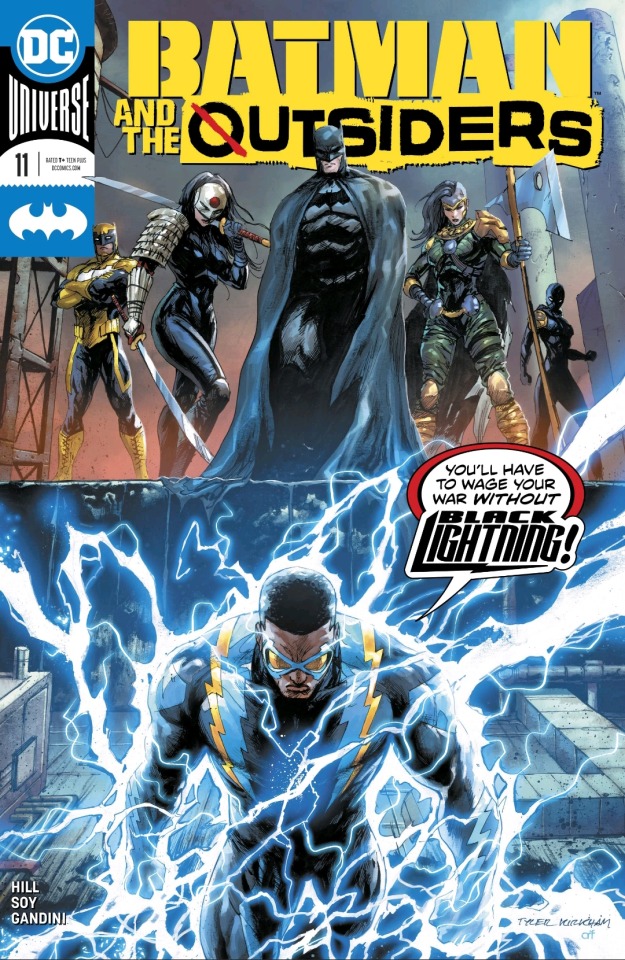
It’s the Outsiders vs The Assassins in a knock-down, drag out fight for their lives!
After Lady Shiva meets up with Jefferson Pierce, aka. Black Lightning, in order to convince him to join her scheme to kill Ra’s al Ghul, she and the electricity powered hero are ambushed by Ra’s al Ghul’s trusted warriors in Ishmael, the turncoat Kaliber and Karma, a villain from Hill’s run on Detective Comics. Luckily for Jefferson and Shiva, Katana arrives in the nick of time with Duke Thomas, The Signal, and Cassandra Cain, Orphan (even though her mother, Shiva, is next to her).
Dexter Soy and Veronica Gandini begin the book with an epic single splash title page, showcasing the two sides as the Outsiders pick their respective opponents. It’s an absolutely beautiful scene with the moon shining in the sky with a bright white while clouds crest over it. The moon reflects on the surface of the water that both sides are standing in, giving the epic stand off a more dynamic feel as the water crashes around them. There’s an unintentionally funny bit where Shiva is standing tall with the Outsiders, but in the background without anyone to look at because the three combatants are closer to the foreground.
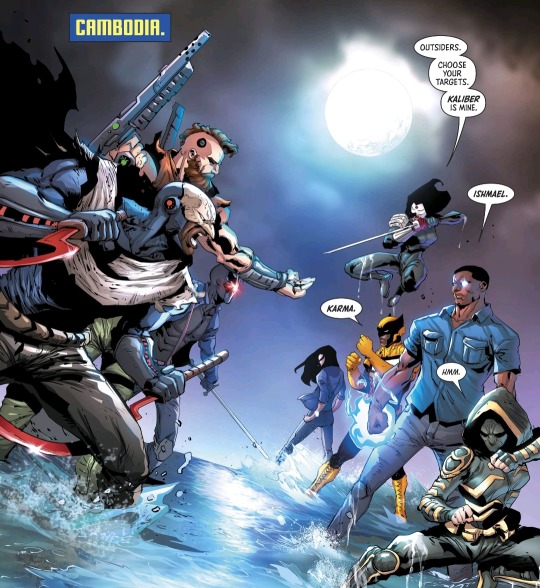
Wonky page aside, Hill does a good job of catching readers up with a few of our characters' reasons for wanting to fight each other while Soy gives us several nice, up close shots of each character in eight panels. Lightning seeks revenge against Ishmael for killing one of the teacher at his school, Duke and Cass want a rematch against Karma for targeting them and injuring Duke back in Detective Comics and Katana faces off against Kaliber for betraying the Outsiders.
Each of their respective fights take place over the course of single pages for most of the issue and while there’s not much in the way of a deep story, the fights do help to expand on who some characters are, give others some catharsis and allows for one to just showcase how cool they are.
Lightning and Shiva’s fight with Ishmael is absolutely one of ideology. Blak Lightning has always been a hero, someone who was willing to save lives and give his own if he thought the cause was worth it. Lady Shiva is one of the deadliest assassins in the DC Universe and only seeks to weed the world of the weak. She sought Jefferson out because she knows that among Batman’s team, Lightning is absolutely one of the most powerful and susceptible to her way of thinking, if the right pressure were to be applied. At the same time, she sees how Ra’s al Ghul’s plot to destroy the planet would be counter to her goals.

Soy portrays Lightning with probably the most intense anger that we’ve seen from him in this story so far. His brow is furrowed and Soy inks a close up shot of Jefferson’s face to accentuate the bright blue and white that Gandini uses for his eyes. His lightning is intense, even as Shiva tells him that she knows he’s holding back, he doesn’t care as he’s acting as the distraction. We then get another page of Shiva enacting his plan.
Soy showcases Shiva’s speed and agility through various panels as she attacks Ishmael. Soy uses speed lines and blurring to convey how quick she can move as Ishmael’s defense is whittled away before she gives him one good kick across the face. Clayton Cowles utilizes excellent lettering with an intense “KRAK” as the foot connects and a powerful “ZZZATTT” as Lightning hits him with a blast of energy. Cowles also has fantastic bubble placement as Shiva counts down on every panel before unleashing Jefferson.
As that fight ends, we get a calm scene between the two as Ishmael lies unconscious in the water, his face just so that he doesn’t drown. Shiva tells Jefferson just how easy it would be to let him drown, but Jefferson points out that that would be murder. Because... of course it would be. Jefferson is a hero and is unwilling to take a life, not because he’s on a team with Batman, but because it’s his decision.

Karma was a Markovian soldier who had something of a past with Batman. This saw him don a mask that allowed him to read the thoughts and actions of his enemies as he targets those who he felt made Batman weak - Duke and Cass. He put them through hell over the course of many issues and this is what initially caused Batman to seek out Jefferson to help train them. This series would have spun out of that arc, but for whatever reason, delays kept it off until very recently.
The fight starts off pretty poorly as Karma reads Cassandra's thoughts, making fun of her Orphan codename, much like I did earlier, and kicks her away. Karma is a quite capable fighter, but he hasn’t faced Duke in quite some time and doesn’t know about the hero’s new found power. Duke had initially had some PTSD when thinking about Karma, likely because of a bomb that the villain had strapped to a Batfan and exploded when Duke arrived to save him.
Duke’s powers over the light had been corrupted by Ishmael earlier in the series and this left him with a new ability to enshroud himself and others in a black shadow. He and Cass use this to their advantage to distract Karma, allowing Soy and Gandini pay off all of their months of pain and anger. Cassandra swings across Karmas face with both of her feet, knocking him back as the glowing red star of his mask leaves a small trail. The fight is honestly pretty one sided from there as Cass just beats the man.

The final fight between Katana and Kaliber is pretty much just an excuse for Soy, Gandini and Cowles to draw cool stuff. Kaliber fires a shot from one of his energy guns with a bombastic, transparent BOOM to accentuate its power and bright orange and yellow colors. Katana gets into an excellent pose and uses her Soul Sword to deflect and spread the blast with a “SHNNNNG” lettering that curves around part of the shot and her sword. Katana has no time to play any games with him, at all.
She also makes short work of him while revealing that she had never liked him. Cowles utilizes similar minimal panels to convey Hill’s script as she tears down his lack of discipline and honor before making fun of his hair while still being threatening. Soy makes Katana look like an absolute badass as she takes Kaliber’s gun arm in one fell swoop before kicking him in the gut. Kaliber may be something of a good eye and a trigger, but Katana, like Shiva, is one of the most dangerous women in the DC Universe with a sword and not someone that should be faced in a one-on-one close quarters fight.
With all of their enemies defeated, Katana holds her sword to Kaliber’s throat as he tries to convince the Outsiders that Ra’s only wants to “save the world.” In some respects, that could be true. He sees humanity as a disease and would rather the planet Earth and his chosen few thrive without the chaff. He’s built a cult of personality around himself and that’s how he’s maintained a following for centuries. Not that it was difficult to convert someone like Kaliber, a stock mercenary. But the merc soon reveals that this fight was meant to serve as a distraction as explosions ring out across a Cambodian town.
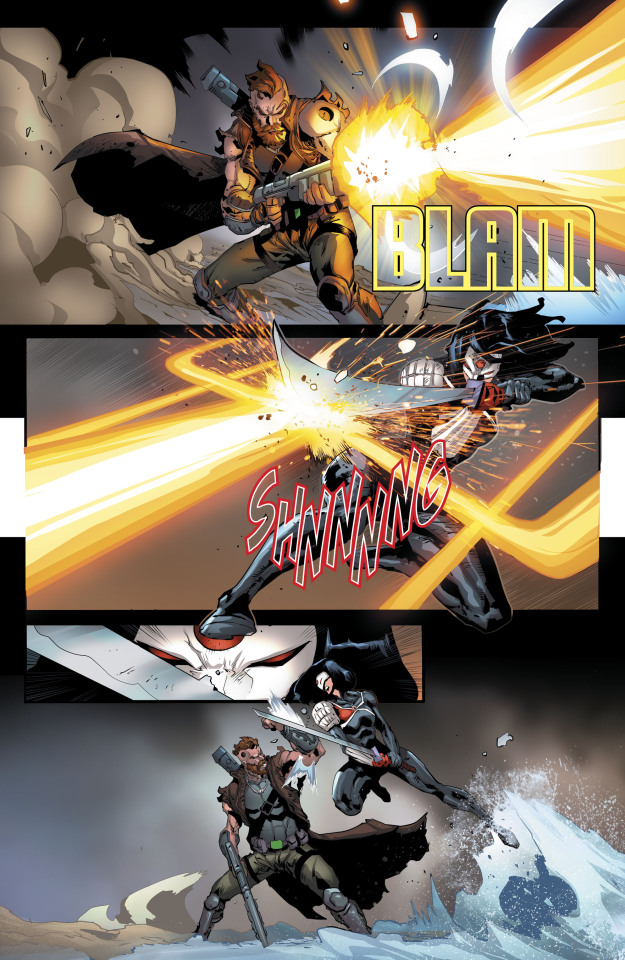
It’s another beautiful scene with the calm blues of the moons afterglow and the night sky itself is contrasted by the bright and fiery oranges of the explosions. My only criticism is that while the scene does feel weighty, there’s still a lot of empty space where more explosions and destruction could be. They sort of feel minor by comparison to the rest of the shot and maybe pulling in closer would help, but either way, it’s a nice scene.
Ra’s goons escape and Katana rallies the Outsiders to go and help the people. Despite not approving of Cassandra choosing to join Batman’s crusade, Shiva affirms her pride and love of her daughter and joins her in heroism, even if it’s only for a short time. Meanwhile, in the background of this story, Sofia, the metahuman who Ra’s initially tried to recruit away from Batman affirms that she wants to do good in the world and Batman leads her to choose her own identity.
Bryan Hill’s excellent Outsiders series continues to be one of the more underrated DC titles out right now as this issue was absolutely action packed thanks to Dexter Soy, Veronica Gandini and Clayton Cowles. It definitely built on these excellent characters that deserve more acclaim and a book separated from having Batman in the title because he is still barely present.

That’s also another point I will keep harping on, Batman is still a non-entity in this book and I think that’s something that this story does well. It allows for Black Lightning and Katana to grow as characters to take on the teacher role like Batman did in the original Outsiders comic. Duke and Cassandra have so much to learn, but so few Batman writers want to put a focus on them while Bryan Hill is giving them center stage alongside two big heroes. They absolutely deserve it and I want to see them in so many more things going forward.
I want this series to go well past fifty issues because it has, consistently, been one of the best paced, best drawn and best told series that DC has had going for it in a long while. This gets another high recommend from me.
Also, support me on Patreon:
patreon.com/TyTalksComics
#batman and the outsiders#the outsiders#black lightning#katana#duke thomas#cassandra cain#lady shiva#bryan hill#dexter soy#veronica gandini#clayton cowles#dc comics#comic review
1 note
·
View note
Text
Licensed Psychologist Dr. Nia

CONNECTION * AFFIRMATION * EMPOWERMENT
Therapy can help you discover the tools within you to write your own story and reach the healing you deserve.
Hi, I’m Dr. Nia (she/her/hers) and I want to congratulate you on taking the first steps towards reaching out for support. Although I am a licensed psychologist, I believe you already have within you the tools that can support your healing journey. I honor the experiences and resiliency that have brought you this far. My goal as a therapist is to create a space where you feel safe and empowered to explore what your own healing may look like. We may practice using new words to describe how you are feeling inside, creating a shared language for your experience and paying close attention. Ultimately, you are in control and I am a guide.
I feel particularly called to work with people of color, women and girls, LGBTQ+ folks, students and young professionals, and those whose identities contribute to difficulties with feeling accepted or valued.
CULTIVATING COMMUNITY AND HEALING
I consider the impact of family, cultural, or societal messages that can interfere with your journey towards wellness and self-love. As a Black woman, I understand the pressure we can feel as we take care of others, sometimes at the cost of our own needs. I am passionate about working with other Black and Brown women who may experience these difficulties as they navigate the everyday demands of work, school, family obligations, and romantic relationships. I support clients to unlearn old strategies that may be self-defeating and learn new ways of coping and being in relationships with themselves and others.
CREATING SAFETY, TRUST, AND SOMATIC HEALING
Drawing on my extensive training in treating trauma, I value creating a space where clients feel emotionally safe. I utilize an authentic and empathic therapeutic style to create a space where clients feel seen, heard, and valued. I model transparency so clients can understand the reasoning behind therapeutic interventions and feel empowered to make informed choices about treatment. When working with trauma, I integrate Psychodynamic, Cognitive-Behavioral Therapy (CBT), Dialectical Behavior Therapy (DBT), Interpersonal Therapy, Motivational Interviewing, and Somatic interventions. I integrate somatic work because our experiences stay with us, not just mentally and emotionally, but physically. Our bodies hold a lot of wisdom about where healing is needed. I utilize body-based interventions to encourage you to pay attention to not only your thoughts and feelings but bodily sensations.This can help you develop trust in yourself to understand what you might be needing in the present moment.
BLENDING CLINICAL EXPERTISE AND CLIENT-CENTERED VALUES
I draw heavily from Psychodynamic, Relational, and Somatic approaches within a multicultural and trauma-informed framework. I collaborate with clients to uncover hidden conflicts while also acknowledging the external pressures that may keep them feeling ‘stuck.’ I can support you in processing childhood trauma, setting better boundaries, increasing coping skills, developing self-compassion, combatting perfectionism, managing stress, and improving work-life balance. Because I know we are often racing to check things off our to-do list, I will focus on slowing down and paying attention to the physical sensations that arise during sessions to increase awareness of what you might be needing in the present moment.
HELPING CHILDREN THRIVE AT SCHOOL AND AT PLAY
Children are naturally curious and still learning the necessary skills for being successful in an adult world.They can feel worried, sad, and angry, but often do not have the language to express these big emotions. Parents and caregivers are an essential part of child therapy and I will work collaboratively with you to best support your child. I use a play therapy relational approach with both verbal and nonverbal interventions (art, movement, therapeutic games, sandtray). This approach allows children to develop a sense of trust and express their emotions in a safe, contained way. Play therapy within the context of a trusting therapeutic relationship can help identify the unmet need underlying a child’s problematic behavior and support parents and caregivers in responding in healthier ways.
NAVIGATING LIFE’S UPS AND DOWNS WITH TEENS
If you are a parent or caregiver who is at your wit’s end dealing with your teen, please know you are not alone in this struggle. Although parent-teen conflict is common in this age group, there is hope for getting through to your teen and improving your ability to connect with them. I have extensive experience treating teens who are dealing with anxiety, depression, trauma/abuse, or have trouble fitting in with their peers. They may also struggle with low self-esteem and figuring out who they are with respect to their identity. I am particularly interested in working with teens who have suicidal thinking or engage in self-harm and other risky behaviors. I use a combination of talk therapy, play therapy, family systems, and somatic approaches to help teens with managing their symptoms, increasing their ability to cope with stressors, and improve their relationships. In my work with teens, I honor their developing independence while supporting their connections to the people who truly care about them.
SUPPORTING STUDENTS, YOUNG PROFESSIONALS, AND ADULTS CREATE BALANCE
It can often feel like there aren’t enough hours in a day. Whether you are in school, working, or both, you are likely dealing with multiple demands while trying to stay on top of everything you need to accomplish. The thought of taking time for yourself makes you feel selfish so you struggle to say “no” to outside obligations. Utilizing a blend of somatic, holistic, and relational approaches, I help clients to develop healthy boundaries while nurturing the relationships that are most important.
HELPING COUPLES AND FAMILIES RECONNECT AND FIND JOY
It’s common for there to be conflict in couples and among family members. Sometimes, these difficulties are impacted by patterns of relating to each other that were developed earlier in life. These patterns can often span generations and be difficult to change. What’s important is that even after a rupture, you can repair the relationship. Using psychodynamic, family systems, and relational approaches, I can support you in repairing those ruptures and improving the quality of your relationships.
I utilize a holistic approach in couples and family work that integrates techniques such as Emotion-Focused Therapy (EFT), Somatic Therapy, and Family Systems interventions. These approaches help you recognize harmful or dysfunctional patterns and rework them while paying attention to the feelings, thoughts, memories, and bodily sensations that arise during interactions with each other. Using this new knowledge, couples and family members can improve their communication, have a renewed sense of attachment, and rediscover joy in each other.
SPECIALTIES AND INTERESTS
Healing for Black and Brown girls and women
Treating trauma and attachment difficulties
Adjustment challenges and dealing with life transitions
Supporting teens with the transition to adulthood
Body image and self-esteem concerns
Coping with depression and anxiety
Healing from grief and loss
Foster care youth and adoption
Acculturation stress
Supporting children and teens of divorce
Helping separated and divorced families with co-parenting
Improving family connection and communication
Reducing self-harm and risky behaviors in teens
Identity exploration
Treating psychosis and mood disorders
Working with parents of children with ADHD
Healing from childhood abuse and inter-generational trauma
Healing from racial trauma and microaggressions
Increasing self-worth and setting boundaries
Improving self-understanding and self-compassion
Managing school and work stress
Women of color issues in school or the workplace
Supporting families with communication challenges
Couples and families navigating trust issues or attachment ruptures
Interracial couples and cross-cultural relationships
CREDENTIALS
Licensed Clinical Psychologist, PSY31472
Ph.D. in Clinical Psychology from the California School of Professional Psychology (CSPP) at Alliant International University.
M.A. in Clinical Psychology from Adelphi University
B.A. in Psychology, minor in Women’s Studies, St. John’s University
TRAINING
Healing Trauma in Children with Play (2019)
Working with Latinx Families (2019)
Dominant and Subjugated Narratives: The Culturally Sensitive Assessment (2019)
Early Childhood Mental Health: Integrating and Assessing Complex Trauma with young children and their families (2018)
Project WHAT- Working with children of incarcerated parents (2018)
CARMA Foundations for Working With Complex Trauma (2018)
Gender & Culturally Responsive Mental Health Practice with African American Male Youth (2017)
Engaging foster youth in Treatment (2017)
Expressive Arts and Drama Therapy (2017)
Trauma-informed Systems Training (2017)
Radical Healing (2017)
Integrative Treatment of Complex Trauma-Adolescents (2017)
LEARN MORE ABOUT DR. NIA
Hear about her views on healing, therapy and more!
READY TO WORK WITH DR. NIA
Contact us today!
1 note
·
View note
Photo




Lorenzo Xavier-Bianchi — Full Character Biography
⚠️ WARNING: ⚠️
Lorenzo's backstory includes instances of abuse and may be triggering. Specific sections that include potentially triggering content will be marked with the warning emoji (⚠️) at the beginning and the end. Skip over the section if you may be triggered by it. The more specific details beyond that he was abused are not extremely important to Lorenzo's character. Proceed with caution and be safe!
✗ General Information: ✗
Name: Lorenzo Bianchi
(FC: Francesco Totti).
Nickname(s): Enzo, Enz, Ghost Boy.
Age: 32 (06/18)
Height: 5’9” (1.8 m)
Weight: 176lbs (80kg)
Born: Sadler, Texas.
Current Residence: Salem Center, Westchester County, NY, USA.
Religion: Agnostic.
Sexuality: Gay.
Relationship Status: Dating Vigor Maximus.
Occupation(s): X-Man.
✗ Personality:✗
Lorenzo is quiet and introverted. He would much rather keep to himself, and read a book or draw, rather than have any sort of contact with any other human being. He hardly considers himself a human being as it is, but rather as a ghost, because of this. It is difficult for him to build even the slightest of friendships because he is so shy, but should he form a bond with somebody, it is likely he’ll latch onto the person, seeing them as one of the few people who truly cares because they didn’t give up on attempting to form a friendship with him. In these cases, he is very gentle, but also very touchy and affectionate, enjoying hugs and cuddles. He is also very childish and goofy in general when he does form a friendship with anybody, as well. Despite his shyness and anxiety, Lorenzo is still very protective of the few people he considers friends and family, especially those within the X-Men, and few other heroes.
Should Lorenzo have to speak to strangers, he is often shaky, he mumbles and he avoids eye contact. He is also very jumpy in general because he can see ghosts and communicate with them. If he isn’t prepared to speak, especially to a stranger, it is highly likely that the sudden initiation of contact and the expectancy of him to speak will trigger his anxiety. Should an anxiety attack be triggered in any way, he often loses control of his powers, and will become intangible and slightly transparent until calmed. Many of these tendencies stem from the fact that he is autistic, and the two often overlap.
In his free time, Lorenzo often hides out in his room on his own. He enjoys reading, writing, and drawing, and often spends hours on end doing so. He is intelligent - perhaps not as smart as other heroes - but more than the average person, and it shows in the way he acts and speaks (when comfortable), and in the way he speeds through even the largest of books. More often than not, he’ll have music going in the background as well when he’s alone in his room, seeing music as a very good distraction from all of his problems. He also has gaming consoles in his room, and he enjoys playing FIFA - it’s the Italian in him. Otherwise, he doesn’t really touch the consoles.
✗ Powers:✗
> Intangibility: The ability to become intangible; the inability to be touched. Using this ability, Lorenzo is able to avoid most, if not all physical attacks, or physical contact of any kind. In its most advanced stages, intangibility may give Lorenzo the ability to levitate and/or fly, and this is something he has been working on for years, however he has not yet been able to achieve it. Should he grab hold of somebody before becoming intangible, he can allow the other person to become intangible as well, however it is difficult for him to do so, especially if he is attempting to pass through solid object such as walls or doors with the other person. Lorenzo will often become intangible if afraid, or if someone he isn’t comfortable with tries to initiate any form of contact. This power requires a strong concentration, meaning coming up against enemies with any other kind of psychic abilities often renders his intangibility useless.
> Invisibility: The ability to become invisible to the naked eye. Lorenzo’s ability to become invisible is often paired with his intangibility, and it is something he does when anxious or afraid. In battle, however, it is sometimes very difficult to manage, because of his shaky and uneasy breathing. More often than not, though, he is focused and calm when in battle, because he has the lives of others in his hands, which is enough to keep him from panicking. Thus, invisibility proves to be useful. Like his intangibility, he can also pass this ability to a second person, should he choose to do so. However, there have been times in battle where his invisibility has failed, and the enemy could still see him one way or another, while no one else could.
> Phantasm Manipulation: The power to manipulate ghosts/specters and their energies. This includes communicating with them as though they were alive and well, like any other person around him. This doesn’t necessarily prove to be useful in any sense for Lorenzo, but rather causes more problems. As a child, the ability made it difficult to focus as so many spirits could be attempting to speak to him at once, however as he’s gotten older, he’s since learned how to control it. Using his powers, he has befriended a few spirits who tag along and help him out, whether in battle, or just when he is having a difficult time. As he’s said time and time again, sometimes he believes he would make a better ghost than a human… He gets along better with them, after all.
> Swordsmanship: Due to persistent paranoia that his powers won't be entirely useful in close quarters combat courtesy of his anxiety, Enzo went so far as to teach himself to fight with swords and knives. He had always idolized gladiators and knights as a child, and his love of history continued well into adulthood, so learning swordsmanship seemed to be the way to go. With the help of of other intelligent mutants, he created a sword that could be compressed to about the size of a pen, and extended with a push of a button to carry with him easily in case of emergency.
✗ Backstory:✗
Despite his mother’s best efforts, Lorenzo lived anything but a normal childhood. Between endless bullying from his classmates and his father, he was beaten down time and time again, and struggled to come back from it all repeatedly. It was hard, and for several years, his mother was his best friend through it all. However, due long hours at the high school, marking and grading papers, Lorenzo's mother was rarely home until the late hours of the evening.
⚠️His father was entrusted with picking a young Enzo up from school on his way home from work, however the abuse began the moment he set foot in the car, typically remaining verbal and minimal until he had alcohol in his system. Sober or not, his father's hatred remained. He resented his son for being a mutant, being one of the individuals to often express their distaste for mutants and rally for their imprisonment or death. His father often likened him to being "sick dog" that he needed to "take out back and put down," and he wasn't shy about telling him to his face. Though drunk and reckless, he was always careful to beat Lorenzo in places where the bruises wouldn't be visible. And, if any were visible, he ensured that his son was too afraid to tell anyone about what was really going on at home. His mother knew of what her son was going through but, as a victim herself, she feared for her son's life, and couldn't stand up to her husband until her son was safe. Working multiple jobs and remaining out of the house for seemingly all hours of the day was meant to be an attempt at creating a better life for she and her son so that they could get away from her abusive husband, but it ultimately made things much worse for her son. She never did fully comprehend what had been going on when she wasn't home as she never witnessed it firsthand, but she had always assumed he suffered the same fate as her... Though there was nothing she could do without putting both of them at risk. In the few years Lorenzo lived at home, he made a handful of trips to the emergency room with broken bones, bruised ribs, and countless other signs of abuse. But, because he refused to talk about what had happened, nothing could be done. On particularly bad nights, or nights when his mother wouldn't come home until the early hours of the morning due to her second job, the abuse became much worse. Although far and few between, on some occasions his father would take him up to the guest bedroom and molest him - something so traumatizing that Lorenzo could only cope with it by pushing it to the back of his mind and acting as though it had never happened at all until he had completely forgotten it had. Simply put, most afternoons Enzo would head home fearing for his life while most kids his age didn't even understand the concept of death. ⚠️
The name calling was the hardest part of it all throughout the years. Physical wounds healed, but the name calling stuck with him, and made his disorder become increasingly worse. The name calling reached it peak when, from a young age, Lorenzo decided he liked boys more than girls, and didn't like when adults would tease him about girlfriends. His father’s remarks began to really take a toll on him, but he could never speak out about it. He resorted to listening to and accepting the homophobic slurs he didn't even quite understand until his very last days in that household, leading him to suppress feelings about his sexuality for years to come.
It was Charles Xavier himself who contacted Lorenzo's mother to discuss her son's unique abilities. He seemed to know everything about him and what was going on at home in ways she couldn't quite comprehend, but regardless, she was thrilled to have found a safe place for him to go, away from his father, and where he could truly be happy and... /Normal/. She explained what Charles Xavier’s School for Gifted Youngsters meant for Lorenzo to her son, and he agreed to go, while she told her husband she was sending their son to a boarding school due to his impressive grades. His father had no complaints; in fact, he was happy to have one less nuisance to deal with, in his own words.
Upon leaving, despite having been rather excited at the mention of the school at first, Lorenzo was miserable. He was only seven, weeks short of his eighth birthday, and he was made to leave the only home he had ever known... Even if it wasn't much of a home. He knew he should be relieved to escape his father, but he wasn't very happy to be away from his mother; the only person he felt he could really trust in his life.
⚠️ Within a short time of Lorenzo leaving the household, his mother became the target of his father's drunken rage and abuse. However, it was short lived, as, now that her son was safe and out of the picture, she was able to call the police, though not without escaping unscathed. She had proof of what had been going on all along, - although she never did come to realize the true extent of what Enzo had faced - and there was no way having him locked away could backfire as her son was under the care of Professor Xavier, now. His father was jailed on multiple counts of abuse and even attempted murder; something Lorenzo only learned of as he reached his teenage years. ⚠️
At first, it was difficult to make friends, and it was even harder to even get any rest at night. It felt as though he was stuck in an endless loop of sadness and misery during a time in which he didn't have the capacity to understand depression and what it meant. He had his own room, unlike many of the other students, as it was the best way to avoid triggering his anxiety. He would often wake up in the middle of the night, screaming, until one of the other students went and found Professor Xavier, or one of the other elder mutants.
As the days went on and the nightly routine continued, Professor Xavier began checking in on him before bed and often throughout the day, just generally spending time with him. He knew Lorenzo felt alone and afraid, and although Lorenzo didn't know of his powers or just how the elder man knew how he was feeling, he was appreciative of the help he offered, even if at first he was afraid to trust him. As the nights progressed he found his nightmares lessening when Charles would come by his room and put him to bed as father would, and occasionally stay for awhile to ensure he slept peacefully. The feeling was foreign to Lorenzo, as his own father had never so much as played catch with him, or even really had a conversation with him, the two formed a bond rather quickly. Charles made him feel safe, and ensured that he knew he would always be protected from anyone who wished to do him harm by Charles himself. He felt silly for looking up to Professor Xavier so much, considering surely many of the other children felt the same way - Charles was a paternal figure to many of the kids here who had no family, why was he any different than them? And so he kept his feelings to himself, unaware of the fact that the elder man had known all along and, in fact, had begun seeing Lorenzo as something of a son to him, as well. Of course, the school was smaller then, and with fewer students to deal with, Charles was happy to spend time with Lorenzo to ensure he felt better, and develop such a bond with him.
As the years went on at the school, Lorenzo found his anxiety lessening from what it once was. There was less to fear, and more to learn - and he did love learning. The longer he was at the school, the more he learned about himself and the rest of the world, and the more he learned to control both his disorder and his powers, so that neither had such a hold on his life. He learned to control and strengthen his powers, and he learned to control his anxiety, so that he could become a hero as well.
Upon growing older and eventually being too old to attend school, Lorenzo instead became one of the main members of the X-Men. He had no intention of going home, as some mutants did. Here, he fit in just fine. And he was enjoying it, quite frankly. At first, it tested him. It tested everything he had worked so hard to achieve. His control of his powers, his anxiety, his strength, his courage… And, frankly, he missed his mother, too. But with persistence, and his new friends, it was just another obstacle he was able to overcome, until he himself was a member of the team. He went so far as to teach himself how to handle knives and swords so that he would always have something to offer in battle. He’d never even dreamed of becoming some sort of superhero, but, through attending the school, it had so easily become a reality, and he was thrilled to have come so far.
Today, Lorenzo works with the X-Men as often as possible, having grown proud of being a mutant through attending the school. He no longer has such debilitating anxiety attacks, but they do happen, especially if he is touched without consent, or if he must talk to somebody he isn’t familiar with. In the field, his anxiety isn’t a problem at all. With help from fellow mutants, he has since learned to focus his mind in battle, so that anxiety is rarely ever a major concern. In addition, he finds that being able to wear a helmet with his suit when out in the field lessens his anxiety as well, as his identity is unknown.
See More...
1 note
·
View note
Text
January 15
Atom Eve was created by the government to be a weapon. At birth, she was switched with a stillborn, and sent home with its birth-parents so as to avoid the government's seizing of her. She was a prodigy in science and received a scholarship to a prestigious school. Her scientific ability turned out to be an early manifestation of her powers. A man approached her one day, warning Eve that her powers may be her downfall and encouraged her to never to use them again. Atom Eve first appeared in Invincible #1(January 15, 2003). Atom Eve joins the Teen Team as an after-school superhero. She soon starts a friendship with Invincible after the two meet saving a shipment of video game consoles from a Mauler twin. Atom Eve is able to manipulate matter at the sub-atomic level by sheer will power. Organic (not animal life, however) and inorganic matter can be changed into anything she desires. She can also fly by lowering the density of the air around her as well as creating force fields.
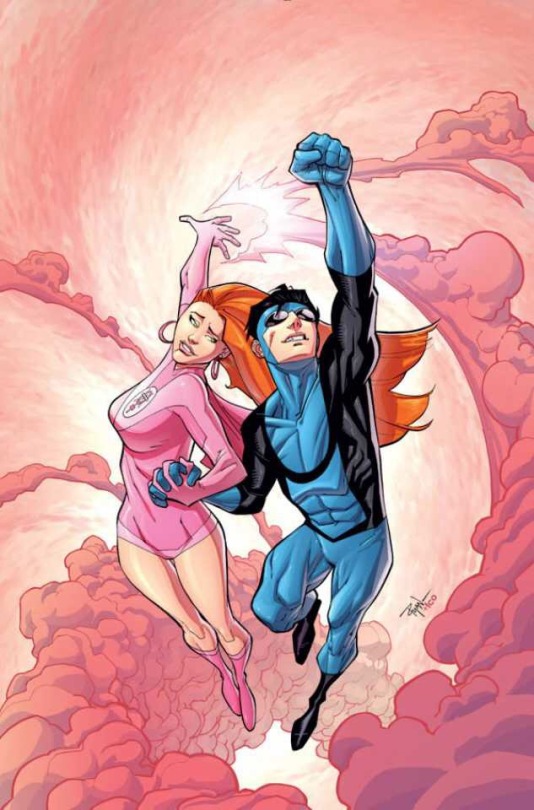
Born in Stuttgart, West Germany, in 1946, Johann Kraus became aware of his psychic abilities when he was ten years old. Frustrated with his inability to help the spirits that appeared to him, he sought out spiritualists in attempts to better understand his powers. Disappointed with occultism, Kraus turned to the church, which allowed him to focus on the spirits themselves rather than the occultist's focus on study and academia. In 1971, he opened an office in Munich, where he became a well-respected medium before relocating to Heidelberg. In early 2002, Kraus was the only survivor of a seance affected by a mystical disaster. His ectoplasmic form survived when his body was incinerated, and knowing he would dissipate without a physical body, he sought out the best paranormal minds on the planet for help: the B.P.R.D. At first, he was sustained inside a transparent tank apparatus developed by the B.P.R.D. for other purposes; eventually the technology was sized down into his distinctive containment suit. Kate Corrigan has said of him that, "He's not dead. He just doesn't have a body anymore." He first appeared in B.P.R.D.: Hollow Earth and Other Stories (January 15, 2003).
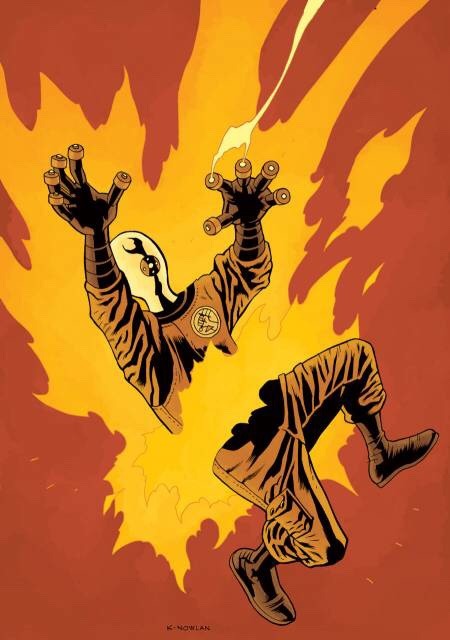
Groo first appeared in Destroyer Duck #1 (January 15, 1982) as a parody of the brutal sword and sorcery heroes who were popular at the time of his creation in the 1970s. Groo is a large-nosed buffoon of unsurpassed stupidity who constantly misunderstands his surroundings. Possessed of superlative skills in swordsmanship he delights in combat but otherwise is a peaceable and honest fellow who tries to make his way through life as a mercenary or by working odd jobs. He is incredibly accident-prone, and despite generally good intentions causes mass destruction wherever he goes. Most of his adventures end with him either oblivious to the mayhem he has wrought or fleeing an angry mob. His penchant for destruction has become so widely known that just the news of Groo approaching is sometimes enough to cause chaos among the population. Groo was one of the first widely successful creator-owned comics, one of the few successful humorous comic books in the United States during its time, and one of the longest-running collaborations in comic book history.
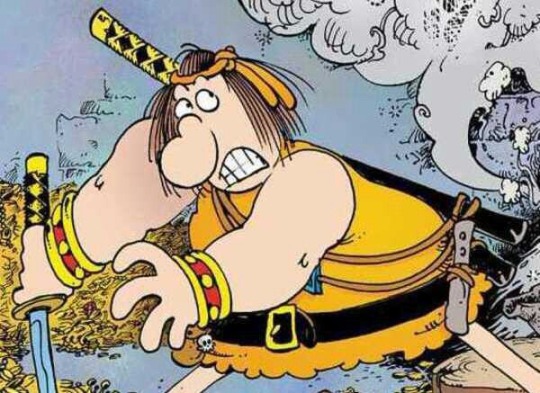
#comics#comic books#comic strip#Image Comics#Atom Eve#Samantha Eve Wilkins#Invincible#Teen Team#Rex Splode#Dupli-Kate#Robot#Guardians of the Globe#Dark Horse Comics#Johann Kraus#Kate Corrigan#Liz Sherman#Abe Sapien#Roger the Homunculus#Hellboy#B.P.R.D.#Groo the Wanderer#Captain Ahax#Arba#Dakarba#Arcadio#Chakaal#geek#history#debut#OTD
18 notes
·
View notes
Text
Transparent Machines
vimeo

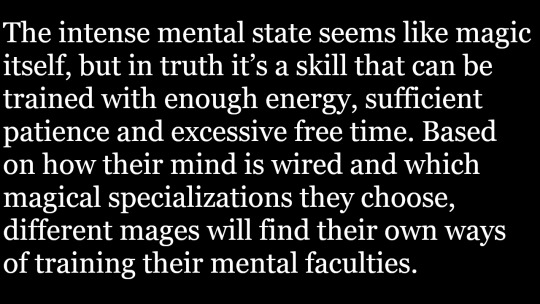

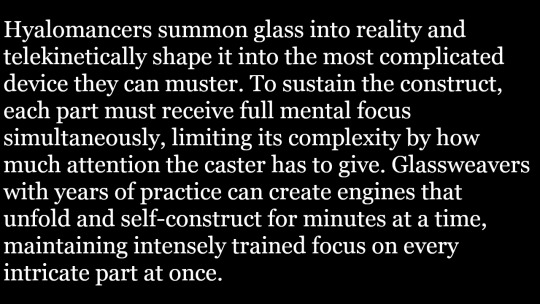

Any mage with ambitions to become a full-on wizard has many challenges ahead, and one is to master a key skill: the ability to hold unbelievable amounts of complex information in their head at once. Powerful spells need a lot of mana, and that means generating an enormous amount of mental activity in order to rip open a hole in the Aether and control the outpouring mana.
The intense mental state seems like magic itself, but in truth it’s a skill that can be trained with enough energy, sufficient patience and excessive free time. Based on how their mind is wired and which magical specializations they choose, different mages will find their own ways of training their mental faculties.
Hyalomancy is a family of spells which harness glass. It’s a secondary specialization most common among combat-oriented geomancers, who can summon clear barriers to reduce the impact of incoming attacks before turning the sharpened shards upon aggressors. Advanced techniques require strong spatial awareness and attention training, which the glassweavers train for hours at a time through a mental exercise they call Transparent Machine.
Hyalomancers summon glass into reality and telekinetically shape it into the most complicated device they can muster. To sustain the construct, each part must receive full mental focus simultaneously, limiting its complexity by how much attention the caster has to give. Glassweavers with years of practice can create engines that unfold and self-construct for minutes at a time, maintaining intensely trained focus on every intricate part at once.
The ones with a sense of humour will take Transparent Machine a step further by making it into a bet, competing to see who can create the most convoluted way to fire a single glass bead across a room. The rest of Ascendant society takes this as further evidence of a stereotype that mages are unproductive timewasters, but the hyalomancers see their games as the best type of activity: self-improvement and fun wrapped into one.
Yaldev is a fantasy/sci-fi worldbuilding project based on Beeple art. Through a combination of narratives, in-universe documents and stylized loredumps, it reveals the story of a planet in magical pandemonium, the nation which rose to conquer it, this empire’s inevitable collapse and the new world which emerged in its wake. The project has major themes about perspective, imperialism, nationalism, nature and the metaphysical battle of law against chaos. For all stories in chronological order, check out the pinned post on the subreddit at r/Yaldev, or this album on the Facebook page!
#beeple#fantasy#scifi#worldbuilding#writing#everyday#short story#surreal#dystopia#dystopian#dystopian fiction#science fiction#sf#science fantasy#sci fantasy#sci-fantasy#scifantasy#worldbuild#worldbuilder#worldbuilders#magic#cyberpunk
0 notes
Text
Some info on the “Hero of the Stars” and his team.
So I decided that now that I have some time to do so, I made a little post which explained the space team I’ve created in the universe of Team Prototype. I want to state that this team is in NO WAY canon, and are simply just a group of me and some other friends’ OCs made in this universe.
Team Prototype belongs to @yark-wark / @teamprototype – check them out bc they’re cool ok
——————————————————-
Desmond Sid (Leader of the team & scouter, comic book nerd, wannabe hero, the “Hero of the Stars”)– Desmond is a Shkeel who had big dreams turn into even bigger dreams. As a child he wanted to become a vault guard; however he began reading comics and it kinda went from there and it fueled his dream to be a hero known in space. Enthusiastic, outgoing, and annoyingly egotistical he leads a small team that takes jobs to earn a name for themselves. A bit of a flirt and somewhat of a charmer, he left his home planet and began to recruit members for his team– a job he still does. While he is upbeat, Desmond is smart and analytical and tries his best to look at a situation from different angles. His ego however can lead him to some serious trouble if not kept in check. Being that he has no thumbs, he uses a sort of kunai-like throwing knife that he can hold thanks to the rings the bottom of them.
Fusillian (Second-in-command, xenoanthropologist, the one keeping Desmond in check, nicknamed “Fus”)– Fusillian is an alien who studies xenoanthropology which is the study of other races’ cultures and lifestyles. He is, like Desmond, analytical and thurough as well as quite intelligent. He is mostly serious and is dedicated to his research. He takes in specimen as well, and studies from time to time. He can provide the team with certain information relating to his field of study if they need it for any mission they go on. He uses his wits (and a powerful tail) to defend himself if ever need be.
Saiko (Occasional ally to the team, rival to Desmond, resident hothead and weeb)– Saiko is an Aqualine with a bit of a hot temper, literally: He has the ability to manipulate fire, and wears rings that are his trinket of focus. While he is a performer on his planet, don’t assume that he is defenseless. As quick on his feet as he is caught off guard and unprepared , he can use his fire manipulation in combat situation as well, even though he is more of the type to be in somebody’s face than to attack from afar. However, he can be specific with what part of the target is hit with fire, having good accuracy. As stated, fire and fists are his forte.
Annestyn (Resident fighter of the team, expressive and outgoing, Rival to Preston and possibly Desmond’s gf??, goes by “Anne” for short)– Anne is a Razorwing who resembles a falcon. She has augmented legs to better perform as a runner of (totally not illegal) mail and such. She returns Desmond’s love, and has a crush on him as he does on her. Her fighting game is only really in her kicking game and some efficiency with guns. She’s quite emotional and has the sometimes Achilles Heel-like tendecy of growing too close to others. She has a bit of disdain for both Razorwings and Direwings, claiming that they’ve never done anything for her. Kicks and guns are her go-to weapons.
Preston (Occasional team member, shifty scavenger, even shiftier information broker, rival to Anne and Louis, Poncho boy, im not your friend, but im not your enemy either.“)– Preston is a Direwing scavenger resembling a crow that can be best be explained when you think of Izaya from "Durarara!!” He’s shifty and mysterious, always seeming to switch sides and constantly having some sort of ulterior motive that benefited him. He provides the team with information on locations, people, and other things occassionally. Nobody can really ever tell what his true intentions are. Snarky, annoying, and seeming skilled in always knowing how to piss others off, he keeps a cool head and a creepy smile. He views Razorwings as inferior, like most Direwings do. He has a large scar starting at the lower left side of his body and ending just under his right cheek. He uses a knife named “close shave” and a blaster called “contemplater” as his weapons of choice.
Louis (occasional team member, more or less an enemy of Preston, gunslinger, smoker, major bummer)– Louis is a Razorwing resembling an eagle with augmented eyes to see in the night and farther distances. He, like Saiko, has a temper and like Fus he takes his job very seriously. He smokes which nobody likes and tends to disregards everybody’s opinion of. Accurate when it comes to gunfighting but sucky when it comes to anything else, Louis more or less is tasked with coming up with game plans and going on recon missions for the team when his help is needed. Him and Preston run into each other often and almost always come to blows when they meet up. Louis is serious almost all the time and it’s hard for him to take “no” for an answer. He uses firearms in fights if he is ever needed in one.
Sinclair (Team’s job finder, Anne’s former caretaker, overprotective and determined, has goals of his own, “Desmond just stop talking”)– Sinclair is a Gorm who looks for jobs the team takes. He was once a caretaker on Techkanis and was the one who raised Anne. Thanks to this the two have a close relationship; however, they do their best not to let that get in the way of their seperate jobs. He does his research and makes sure he knows as much about any jobs that he comes across or considers for the team. However, he isn’t totally transparent: Sinclair has his own motives and personal secrets to deal with and will stop at nothing to get loose ends tied. He’s extremely protective of Anne. Desmond calls him “robot dinosaur” and he hates it. Being not patrticularly good with much he’ll use whatever he can in a fight.
And that’s it, the whole crew. me and my friends poured a good bit of time into them, despite obviously just being made for the fun of it and because of how much we like the lore of TP. Again, Team Prototype belongs to @teamprototype .
1 note
·
View note
Text
Crazy GW2 ff-ideaton for self (I’ll forget it all anyway):
- Action/adventure
- OC investigates Pact fleet destruction/Trahearne’s death years after.
- Revenant abilities and HoT PTSR.
- The world is bad, worse then in-game.
- Being Commander is shit.
- Commader is “the hero Gotham deserves”.
- Being everyone else is shit.
- Dysfunctional trammander.
- Being “a part of a junge dragon” is shit.
An ongoing detective/action/adventore story that takes place 10y+ from now.
- OC, for instance a young promising Shining blade exemplar (Who are they? What would they do? First thought - a headstrong tomboy, similar to Korra’s Kuvira).
- SBs are preparing for something dramatic (The “enter-the-plane-of-torment-dramatic, but what exactly?).
- OC has their own team.
- As they look for the support, they try to reach the remaining members of Dragon’s Watch, who refuse to take part in a suicidal mission for “I wanna get a life” reason. They never refuse to help with advice or intel, but will not accompany the OC.
- Anise believes Kerida/Lidia will be a good place to start. That’s how the idea of recruiting the legendary Commander/Dragonslayer comes to life.
- Commander is my own Shiro/Dragon/Renegade sylvari revenant because I can.
- Kerida thinks low of the Commander “thinking capabilities”. Recruiting him is spoken of as -a very bad idea- as he is universally considered an unpredictable living doomsday weapon nobody can effectively control. But the situation calls for drastic measures and only few people in Tyria are intense enough. The OC is worried, but also excited.
- Commander is found in Cantha, which has opened its borders by then, and he eerily reminds Shiro Tagachi in both appearance and abilities. Maybe not.
- OC views PC’s revenant skills - tearing thought the Mists - as wounds in the world and is initially frozen with terror. They overcome this feeling with time, but they also realize why nobody wants to deploy the Commander unless they absolutely have to.
- Legends have VUI (like Suicide Squad’s ”Enchantress”. Probable code phrases: Shiro - “Murderer”, Glint - “Here be dragon”, Kalla - “Renegade”, Mallyx - “Unyielding”. No Ventari or Jalis, PC is negative/offensive combatant). OC notices how the commander mutters something in combat, but never hears the exact words.
- With time, OC begins to notice small shifts in the PC’s behavior due to legend invocation and can’t help wondering what exactly is left of the dragonslayer’s own persona and why he allowed himself to become what he is - literally an unthinking doomsday weapon.
- Back to DR, the SBs proceed with their preparation. Everyone is obliged to reiterate SB’s vows in the presence of a mesmer - to face their fears/desires, reveal their hidden interests and strengthen their minds. OC believes it is a good idea and everything goes well until
- PC kills the inquisiting mesmer in front of witnesses and refuses to explain why.
- Lady Meade oversees the process as an extra measure of safety. It seems she may have a clue - but she will never reveal it.
- Commander is to be released because of the mission, being the Commander and being universally accepted “bad enough”. OC tries to confront him, but PC’s comments are cryptic - ”I didn’t kill the mesmer” and “we all understood the risks, no exceptions”.
- OC investigates. Something (WHAT WHAT WHAT???) tips them off to find out what “really” happened in Maguuma jungle about 12 years ago.
- The official version of the Pact’s First Marshal death is “slightly” different from the truth. The fact that the PC killed him was concealed from the public to save what little remained from the Pact’s positive image. This was PC’s idea, supported by the rest of the high command and the few witnesses. Ridhais, who actually recovered the body, was gently persuaded to keep quiet with a lifelong pension and the Pact’s full support and protection. PC also found the way to make the Pale Tree hide the whole picture.
- During the later confrontation with the PC, OC learns he had his own reasons for the many detours during Maguuma campaign and Rata Novus recovery. With the rest of the high command MIA/absent, PC’s priorities were with successful reestablishment of the Pact. In the end it costed him his sanity, earned him the impression of a mindless living weapon but worked well enough. OC is deeply disturbed and disgusted with the knowledge that the Pact was not transparent.
- In Maguuma, OC recovers some letters Trahearne and Commander exchanged during the Zhaitan campaign, as well as Trahearne’s later diary/album of letters that were never sent. OC reads it though and thinks it’s a fake, because it looks like a very unrealistic romance novel. OC tries to investigate who would benefit from compromising the high command, with no success. At some point, OC thinks the discovery has to be published or at least safekept with Priory, truth or not, but decides it can wait.
- OC is enrolled in a SB’s mission for “previous effort’. The mission includes: mists, ghosts, sacred vows, runes, rituals, tons of magic.
- Blah blah blah
- OC and PC meet Trahearne. Each has a very painful discussion with him.
- OC learns the second opinion about the Maguuma campain and thinks it looks ugly enough to be glad First Marshal died when he did. If not for the Big Statue and the Big Sacrifice talk, he would be charged with high treason for the fleet destruction, the Commander would be charged with high treason for the desertion (Eir was right!), Pact’s reputation would be ruined, Almorra would never be able to regain control during the White Mantle/Lazarus crisis, DW would be dead or scattered (probably for the best), Aurene would be a weak and sickly hatchling and probably wouldn’t survive. The world would be very different.
- Add some personal background here: OC thinks about small events changing the big picture and realises their own life would be total shit in this different world. Maybe a slave to the White Mantle/bloodstone ghoul? idk, ideas?
- OC overhears some of PC and Trahearne’s talk, which is very personal. T describes what it was like to be a part of a jungle dragon. Neither expected the experience would cause PC’s revenant abilities to manifest. OC realises the “wound in the world” description is accurate.
- “Commander, the Pact” was T’s message to himself to preserve self-awareness: something that existed and was important regardless the connection to Dream and Mordremoth. T is partially responsible for Modrem attacks on the Pact camps. T believes he was powerful enough to contain the jungle dragon, but the perspective of living like this was terrifying, so he is grateful for going down as his own man (more or less). T is super-sorry this caused the Commander turning himself into a living weapon. Both say they would wish a different, happier fate for another.
- PC admits Caladbold has its own happy memory about T and he wouldn’t want to end with his mind’s eye image. OC realises a) PC doesn’t believe this conversation is happening, b) why PC could kill the mesmer. They don’t want to check the last part.
- Blah blah blah
- Back to DR/Cantha, OC hands the recovered letters and notes to PC.
Shorter version: start with PC killing the mesmer. Skip the first part.
I don’t have PoF yet so I don’t know how far madness goes there.
Now the big question: what would the OC be doing outside reading someone else’s correspondence?!! What is the original mission?
What team would they assemble?!!
Mind, focus on the important stuff next time plz
#dysfunctional trammander#rationalizing gw2 shit#gw2 au#gw2 fanfiction ideas#heart of thorns was creepy and i like it#nlp in gw2#evil enchanted tree
1 note
·
View note
Text
Clinical Psychologist in Berkeley

CONNECTION * AFFIRMATION * EMPOWERMENT
Therapy can help you discover the tools within you to write your own story and reach the healing you deserve.
Hi, I’m Dr. Nia (she/her/hers) and I want to congratulate you on taking the first steps towards reaching out for support. Although I am a licensed psychologist, I believe you already have within you the tools that can support your healing journey. I honor the experiences and resiliency that have brought you this far. My goal as a therapist is to create a space where you feel safe and empowered to explore what your own healing may look like. We may practice using new words to describe how you are feeling inside, creating a shared language for your experience and paying close attention. Ultimately, you are in control and I am a guide.
I feel particularly called to work with people of color, women and girls, LGBTQ+ folks, students and young professionals, and those whose identities contribute to difficulties with feeling accepted or valued.
CULTIVATING COMMUNITY AND HEALING
I consider the impact of family, cultural, or societal messages that can interfere with your journey towards wellness and self-love. As a Black woman, I understand the pressure we can feel as we take care of others, sometimes at the cost of our own needs. I am passionate about working with other Black and Brown women who may experience these difficulties as they navigate the everyday demands of work, school, family obligations, and romantic relationships. I support clients to unlearn old strategies that may be self-defeating and learn new ways of coping and being in relationships with themselves and others.
CREATING SAFETY, TRUST, AND SOMATIC HEALING
Drawing on my extensive training in treating trauma, I value creating a space where clients feel emotionally safe. I utilize an authentic and empathic therapeutic style to create a space where clients feel seen, heard, and valued. I model transparency so clients can understand the reasoning behind therapeutic interventions and feel empowered to make informed choices about treatment. When working with trauma, I integrate Psychodynamic, Cognitive-Behavioral Therapy (CBT), Dialectical Behavior Therapy (DBT), Interpersonal Therapy, Motivational Interviewing, and Somatic interventions. I integrate somatic work because our experiences stay with us, not just mentally and emotionally, but physically. Our bodies hold a lot of wisdom about where healing is needed. I utilize body-based interventions to encourage you to pay attention to not only your thoughts and feelings but bodily sensations.This can help you develop trust in yourself to understand what you might be needing in the present moment.
BLENDING CLINICAL EXPERTISE AND CLIENT-CENTERED VALUES
I draw heavily from Psychodynamic, Relational, and Somatic approaches within a multicultural and trauma-informed framework. I collaborate with clients to uncover hidden conflicts while also acknowledging the external pressures that may keep them feeling ‘stuck.’ I can support you in processing childhood trauma, setting better boundaries, increasing coping skills, developing self-compassion, combatting perfectionism, managing stress, and improving work-life balance. Because I know we are often racing to check things off our to-do list, I will focus on slowing down and paying attention to the physical sensations that arise during sessions to increase awareness of what you might be needing in the present moment.
HELPING CHILDREN THRIVE AT SCHOOL AND AT PLAY
Children are naturally curious and still learning the necessary skills for being successful in an adult world.They can feel worried, sad, and angry, but often do not have the language to express these big emotions. Parents and caregivers are an essential part of child therapy and I will work collaboratively with you to best support your child. I use a play therapy relational approach with both verbal and nonverbal interventions (art, movement, therapeutic games, sandtray). This approach allows children to develop a sense of trust and express their emotions in a safe, contained way. Play therapy within the context of a trusting therapeutic relationship can help identify the unmet need underlying a child’s problematic behavior and support parents and caregivers in responding in healthier ways.
NAVIGATING LIFE’S UPS AND DOWNS WITH TEENS
If you are a parent or caregiver who is at your wit’s end dealing with your teen, please know you are not alone in this struggle. Although parent-teen conflict is common in this age group, there is hope for getting through to your teen and improving your ability to connect with them. I have extensive experience treating teens who are dealing with anxiety, depression, trauma/abuse, or have trouble fitting in with their peers. They may also struggle with low self-esteem and figuring out who they are with respect to their identity. I am particularly interested in working with teens who have suicidal thinking or engage in self-harm and other risky behaviors. I use a combination of talk therapy, play therapy, family systems, and somatic approaches to help teens with managing their symptoms, increasing their ability to cope with stressors, and improve their relationships. In my work with teens, I honor their developing independence while supporting their connections to the people who truly care about them.
SUPPORTING STUDENTS, YOUNG PROFESSIONALS, AND ADULTS CREATE BALANCE
It can often feel like there aren’t enough hours in a day. Whether you are in school, working, or both, you are likely dealing with multiple demands while trying to stay on top of everything you need to accomplish. The thought of taking time for yourself makes you feel selfish so you struggle to say “no” to outside obligations. Utilizing a blend of somatic, holistic, and relational approaches, I help clients to develop healthy boundaries while nurturing the relationships that are most important.
HELPING COUPLES AND FAMILIES RECONNECT AND FIND JOY
It’s common for there to be conflict in couples and among family members. Sometimes, these difficulties are impacted by patterns of relating to each other that were developed earlier in life. These patterns can often span generations and be difficult to change. What’s important is that even after a rupture, you can repair the relationship. Using psychodynamic, family systems, and relational approaches, I can support you in repairing those ruptures and improving the quality of your relationships.
I utilize a holistic approach in couples and family work that integrates techniques such as Emotion-Focused Therapy (EFT), Somatic Therapy, and Family Systems interventions. These approaches help you recognize harmful or dysfunctional patterns and rework them while paying attention to the feelings, thoughts, memories, and bodily sensations that arise during interactions with each other. Using this new knowledge, couples and family members can improve their communication, have a renewed sense of attachment, and rediscover joy in each other.
SPECIALTIES AND INTERESTS
Healing for Black and Brown girls and women
Treating trauma and attachment difficulties
Adjustment challenges and dealing with life transitions
Supporting teens with the transition to adulthood
Body image and self-esteem concerns
Coping with depression and anxiety
Healing from grief and loss
Foster care youth and adoption
Acculturation stress
Supporting children and teens of divorce
Helping separated and divorced families with co-parenting
Improving family connection and communication
Reducing self-harm and risky behaviors in teens
Identity exploration
Treating psychosis and mood disorders
Working with parents of children with ADHD
Healing from childhood abuse and inter-generational trauma
Healing from racial trauma and microaggressions
Increasing self-worth and setting boundaries
Improving self-understanding and self-compassion
Managing school and work stress
Women of color issues in school or the workplace
Supporting families with communication challenges
Couples and families navigating trust issues or attachment ruptures
Interracial couples and cross-cultural relationships
CREDENTIALS
Licensed Clinical Psychologist, PSY31472
Ph.D. in Clinical Psychology from the California School of Professional Psychology (CSPP) at Alliant International University.
M.A. in Clinical Psychology from Adelphi University
B.A. in Psychology, minor in Women’s Studies, St. John’s University
TRAINING
Healing Trauma in Children with Play (2019)
Working with Latinx Families (2019)
Dominant and Subjugated Narratives: The Culturally Sensitive Assessment (2019)
Early Childhood Mental Health: Integrating and Assessing Complex Trauma with young children and their families (2018)
Project WHAT- Working with children of incarcerated parents (2018)
CARMA Foundations for Working With Complex Trauma (2018)
Gender & Culturally Responsive Mental Health Practice with African American Male Youth (2017)
Engaging foster youth in Treatment (2017)
Expressive Arts and Drama Therapy (2017)
Trauma-informed Systems Training (2017)
Radical Healing (2017)
Integrative Treatment of Complex Trauma-Adolescents (2017)
LEARN MORE ABOUT DR. NIA
Hear about her views on healing, therapy and more!
0 notes
Text
2020 predictions for mobile marketing

Previous predictions: 2019 predictions for mobile marketing, 2018 predictions for mobile marketing, 2017 predictions for mobile marketing, 2016 predictions for mobile marketing
For the fifth year running, Mobile Dev Memo presents a set of predictions on what the coming year may bring with respect to mobile marketing. As with last year, I consulted a number of venerated marketers (and myself) from a broad set of mobile verticals in compiling the predictions.
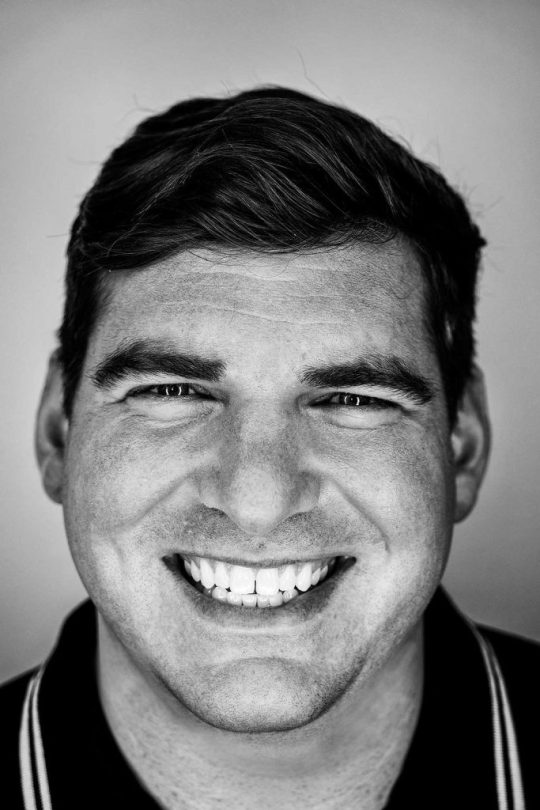
Eric Seufert
Owner of Mobile Dev Memo and QuantMar, author of Freemium Economics, and formerly marketing at N3TWORK, Rovio, Skype
2019 saw the development and amplification of a number of broad economic themes that I believe will impact the mobile marketing ecosystem in specific ways throughout 2020. Primarily, I expect to see a general pullback in marketing spend on Facebook and Google as “growth stage” companies, especially those funded by SoftBank, apply more discipline to their marketing budgets. Via the IPOs of Uber, Lyft, and Slack (and WeWork’s failed IPO process), companies now understand that the growth-centric laws of physics that dominate private company valuations don’t apply in the harsh crucible of the public markets: public investors demand paths to profitability, transparency, and financial self-control.
Absent the profligate marketing spend on Facebook and Google from the likes of many growth-stage companies with large pools of cash to spend indiscriminately on ads, performance marketers driving systematic growth might find a more welcoming environment in 2020.
Another trend I see taking more pronounced form in 2020 is the death of the CMO role for mobile-first companies as the monetization and direct response marketing functions merge into the broader Growth operation. This feels inevitable as event-drive, algorithmic campaign management dominate Facebook and Google advertising: without oversight of and impact on monetization, marketing teams are incapable of properly optimizing mobile ad spend with event-driven campaign strategies like AEO and VO on Facebook and Google’s UAC. This will be even more true if Facebook’s version of UAC rolls out in 2020; marketing teams that do not control monetization design and strategy will simply be ineffectual.
This, to me, spells the death of the notion of a exclusively marketing-oriented executive for mobile-first companies that grow primarily through direct response marketing: without deep analytics and monetization design experience, a marketing leader cannot properly scale a mobile-first business.
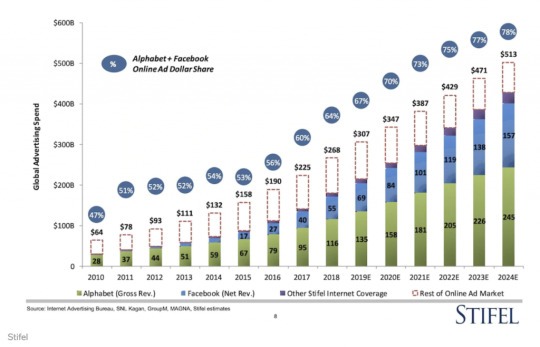
Finally, I believe 2020 will produce further stratification at the bottom of the SAN (self-attributing network) category: in this post, I presented a two-tier hierarchy of SANs on mobile, but I can foresee the second tier of that hierarchy splintering as the smaller and less-reactive platforms lose market share to Google and Facebook, which continue to dominate on mobile. In 2020, I believe the SAN category will develop into a four-tier system represented by:
Tier 1: Facebook, Google
Tier 2: Amazon, Snap, Apple (Search Ads), TikTok (in the second half of the year)
Tier 3: Twitter, Pinterest
Tier 4: Reddit, Quora
As the SAN category fractures, I believe programmatic in-housing ultimately grows: large advertisers will take programmatic media buying in-house to build the tools and targeting logic that the slower and less evolved platforms haven’t delivered.

Hila Qu
VP Growth at Acorns, Best selling Growth Book Author
In the past 3 years, I have been working on the front line of mobile growth in the super competitive fintech space, and I have observed some trends that I think will continue in 2020.
First, no new large-scale acquisition channels have opened up, therefore the Big 2 Google and Facebook are likely to become even more crowded and expensive. To combat an ever-rising CAC, mobile growth teams must take a “full funnel approach.” Intensive AB testing & product-driven growth are a necessity today, and mobile growth teams have to have both channel experts and growth product managers / engineers to be successful.
Second, both Google & Facebook are pushing advertisers to largely rely on algorithms, and that trend will continue. Mobile growth teams will spend less time on managing individual campaigns and more time monitoring real-time analytics and making tweaks based on spend recommendations. Channel expertise will be less critical, and the ability to produce a high velocity of new creatives to feed into spending algorithms powered by data scientists are key ingredients for success.
Lastly, back to basics: in the past few years, tons of venture money accelerated innovation but also acted like “growth steroids” to train some companies into pursuing vanity metrics. In 2020, as the overall economy & venture market cools down, companies have to go back to the basics: is LTV > CAC? By how much? What is the payback period? The focus on incrementality will be huge too as money becomes tighter.

Thomas Petit
Growth consultant and start up advisor
Status Quo
I don’t believe much change will happen in sources distribution, Facebook & Google will keep their oligopolistic 2/3rds share of the UA market, although that percentage may have peaked as marketers get increasingly concerned by dependency;
Event / Value optimization on Facebook and Google still won’t be able to incorporate more than 1 value to reflect complex user flows & monetization schemes;
The two main app stores will retain their hegemony, with the distant threat from third party stores & PWA failing to reach critical size, at least within the next 12 months;
Privacy will make headlines, but nothing fundamental will change in the adtech industry. Business as usual.
There will be blood!
App stores are winner takes all by nature and the middle class will suffer in 2020: I sadly foresee the firesale (if not bankruptcy) of several mid-to-large developers, both in gaming and non-gaming. Some of the worsening factors include the impact of new iOS subscription scheme, the extreme competition in hypercasuals, or the pressure from VCs to shift strategy 180º from volume to profitability in some verticals;
Important evolutions will affect tools & vendors. Watch out in particular for the CDP and programmatic in-housing markets growing, the MMP war intensifying, while new creative automation services and data modeling tools will emerge this year;
The leading UA metrics will move further down the funnel towards complex p-LTV ROAS models to avoid short term focus.
I predict the biggest change of 2020 to be on marketing teams structure & roles:
There will be even less UA managers processing media buying, especially with Facebook’s incoming “AAA” mimicking UAC;
Designers, data analysts and even engineers will stop servicing marketing teams to becoming their core pieces. Data analysis in particular will be even more highly sought after, for instance to feed algorithmic bidding with better predictive events / predicted value;
A new role will emerge: the “creative manager,” a mixed role unifying creativity and analytics, interpreting hard data into actionable insights, enhancing the ideation quality and automating testing process;
ASO reaches maturity and requires more senior roles, transitioning to broader organic growth management illustrating the holistic and cross-functional nature of the discipline;
From UA to marketing to growth: as acquisition, retention & monetization get more intertwined than ever, many marketing teams will somewhat merge with product & CRM into complex cross-functional growth teams, an organizational evolution that will be a tricky challenge to structure successfully;
The sum of all above will result in increasing complexity of senior marketing roles, and provoke massive turnover among VP Marketing/CMOs. Hiring for such roles successfully will be a struggle.

Simon Lejeune
Head of User Acquisition at Hopper
2020 will be the year of Facebook’s version of Universal App Campaigns, rolling out worldwide. Adoption could be mandatory by 2021. The automation and commoditization of user acquisition keeps accelerating. Investors will ask less how you’ll grow your user base and more how you’ll monetize it;
More and more campaigns will be automatically created and updated on top of product feeds. These campaigns will be algorithmically optimized with revenue and LTV data continuing to be happily handed over to Facebook and Google;
Marketers continue behaving more like plumbers, making sure the right data flows to the right place — or architects if you prefer that comparison. Automation will level the playing field and allow small teams to be even more competitive against big companies. (Truly cross-platform marketing tools and features may begin to breakthrough in the martech field. The rivalry between Apple, Facebook and Google and ever-growing privacy concerns will make attribution headaches more frequent.);
The Google and Facebook duopoly will probably grow stronger. But just like Google, Facebook might become greedier as they’re reaching saturation. And as more advertisers keep pouring more money into Facebook, CPMs inflation could accelerate. Panicked performance advertisers will experiment more on other social media and allow for lower returns, which should help smaller platforms stay afloat. (The only TikTok 2020 prediction I can make is that we’ll see more of TikTok in the news. But between paid ads priming the pump, yet to be seen retention rates and China-related backlash, anything can happen.);
Someone will spend dozens of millions of dollars in mobile Facebook ads and become the next President of the United States. Facebook will inevitably be accused of both having no impact at all and of being a careless evil king maker while we keep struggling to understand how social networks actually affect society and what to do about it. In the meantime, here’s something Facebook could do about political ads.

Anette Dahlstrøm Ståløy
VP of Business & Marketing at Dirtybit
The numbers of apps in the stores and the competition for visibility in the stores keep increasing year after year, and 2020 will not be an exception. First of all, having a high quality product will be crucial in order to succeed in the coming year. The app store algorithms are getting more and more sophisticated. One of the key success factors for marketers will be the ability to keep up with changes in how the algorithms affect app discoverability and visibility by emphasising stability, performance, engagement and other key user satisfaction metrics. Even though organic reach is getting harder and harder, there is still a lot of potential, and companies large and small need to strive to find their strategy and balance both paid and organic user acquisition;
After years of #programmatic #headerbidding, we will finally see what the hype has been about, with a more mature ecosystem, tech and tools;
In 2020 the market will be dominated by big companies with massive UA budgets in their toolbox. However, there will still be room for mid sized and even smaller teams to succeed, teams with the right skillset, tools and right attitude, and with the willingness and ability to invest in becoming great performance marketers. By the end of the day it’s about finding the right users for your product, retaining them, and keeping them happy so that they will be your ambassadors, referring friends and more users to your product. We are already seeing that app store search accounts for a significant amount of app installs, so it will be more and more important to build strong and recognizable brands;
No matter what 2020 will bring in terms of new tech, genres, platforms or other factors that determine who will succeed – luck will still be an important part of the equation. At Dirtybit we like to say that we always need to optimize for luck!
Photo by Toni Cuenca on Unsplash
The post 2020 predictions for mobile marketing appeared first on Mobile Dev Memo.
2020 predictions for mobile marketing published first on https://leolarsonblog.tumblr.com/
0 notes
Text
The Caligula Effect Overdose Review
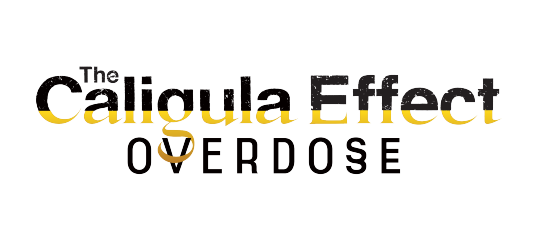
by Amr (@siegarettes)
The Caligula Effect Overdose
Developer: FURYU Corporation
Publisher: NIS America
PS4, PC, Switch
When I originally reviewed The Caligula Effect for the Vita I found it to be a dire RPG, with a half-baked story and combat that was held back by its abysmal technical performance. I questioned the merit of returning to it for a PS4 remake. Still, I was curious if any of the original game could be salvaged. So once again I found myself, like the game’s protagonists, stuck in an endless loop of high school life.
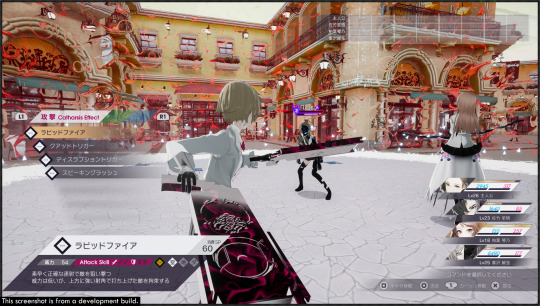
A quick refresher for those who (justifiably) skipped the original release of Caligula: during a speech welcoming the incoming class, you begin to hallucinate, seeing distortions in the world around you, and in the faces of your classmates. You’ve “graduated” and become aware of the true nature of the world, specifically, that it’s a simulation named Moebius, whose residents live an endless loop of high school life, finishing school only to return to their first year again.
Moebius is the creation of Mu, a virtual idol who seeks to bring comfort to fans of hers who’ve experienced trauma, and provide them with a world free of pain. Your attempts to escape Moebius bring you into conflict with Digiheads, people corrupted by their strong desire to escape their lives, and the Ostinato Musicians, students who compose music for Mu and seek to increase her influence. Basically, you gotta fight Vocaloid stans and artists who refuse to stop posting and log off.

To stop them each of the members of the Going-Home Club have to awaken to their inner desires, channeling their strong impulses through the Catharsis Effect, which allows them to fight back against Moebius. Basically their arms turn into guns and stuff.
It’s a loaded premise, full of interesting directions to pursue. Questions about the nature of fandom, virtual personhood, the value of pushing back against a restrictive society and particularly the endless adolescence, are all potent for thematic conflicts. The endless high school life and stunted growth that comes with escapism could easily form a strong meta-commentary, taking aim at the culture and fans of anime and games that constantly returns to high school life and sometimes feels incapable of moving on. Or it could provide commentary on a homogeneous society with little tolerance for aberrations.
Don’t worry, they don’t do anything meaningful with any of these themes. Instead characters get their catharsis by talking at length about how much they hate fat people and other inane garbage, while the main plot relitigates the value of escapism in a format that’s been done better by other games and half the isekai genre.
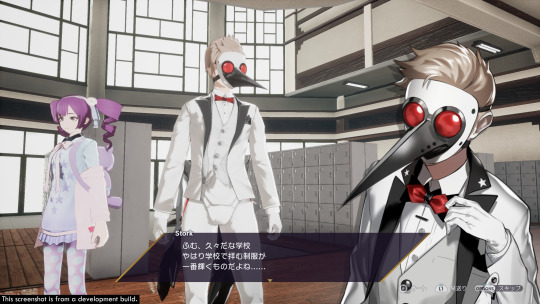
Overdose is largely the same story, aside from allowing you to play as a female protagonist, introducing a few characters (one of which is even more unlikable than the original cast), and adding scenarios that allow you to take sides with the Ostinato Musicians. It definitely bulks up the story, but it’s hard to argue that it meaningfully alters it. The script does get small improvements, and in one case it helps make a character read more like their awakening come as a result of strong determination, rather than having a tantrum.
Most of the meaningful revisions come as a result to changes to the UI and battle system. Functionally, it’s mostly the same, but a visual overhaul and technical changes turn make the game a lot more readable. The UI moves the grungy, noisy art direction to a more fitting pop aesthetic, with the textured black elements becoming lighter, pastel colors with slight transparencies. Battle icons also take up a lot less screen estate, letting the visuals breathe and allowing the hectic and often crowded battles more room before they turn unreadable.
Best of all, the instant battle transitions now bloom into lovely pastel arenas, with digitized effects dancing around the borders, creating a window into the setting around you. The improved presentation works strongly in Caligula’s favor, since the battle system carried me through most of my time with it. Essentially, you’re using a series of predictions to carry out a chain of up to three actions per character, attempting to inflict status effects to interrupt enemy attacks and put them into a vulnerable state.
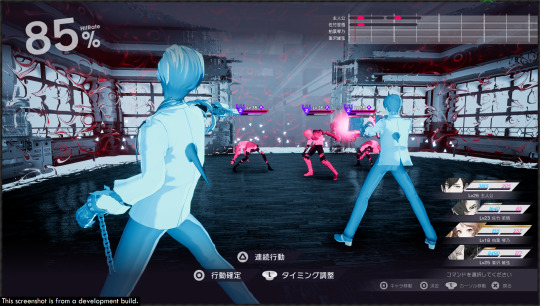
Characters move according to turn order, but their actions occur in real time once executed, and can be fine tuned to better interact with other characters’ moves. For example, you might set one character up to they counter two enemies’ melee attacks and send them airborne, have other characters juggle them with ranged attacks, then have another follow up when the enemy is downed to finish them off. It turns battles into interesting tactical problems, which when dealt with well become spectacles of stylish combos and super moves that lend a flair that calls to mind character action games. With good decision making even bosses can be interrupted and run over with the same momentum, providing a satisfying reward for playing well.
Of course, that’s only when everything plays out the way you want. Caligula throws a wrinkle into its battle system--the predictions of the enemy moves aren’t always accurate. The stronger the enemy the more likely they’ll be able to outwit you, and having backup plans to ensure your combos go off properly is key. Characters also need time to recharge their skill points after a few turns, which requires some long term planning to make sure you aren’t standing around out of energy while the enemy runs you over. These considerations keep battles from being predictable, but also makes an already finicky system more touchy. So while higher level enemies still prove engaging, later battles, with tons of fodder enemies and a larger squad of teammates, turns into a cacophony of abilities and explosions that are honestly better left to the auto-battle option.

At its most messy, these battles still provide the main impetus to keep playing, and Overdose’s welcome makeover helped it get closer to its ambition. It’s the one part of the game I can say I found all around enjoyable. The same can’t be said for its ambitious social system, which incorporates and massive web of characters to talk to, both in person and over the game’s version of the LINE messaging app. There are literally hundreds of these NPCs, each which you can have a quick chat with to raise your affinity with, rewarding you with bonuses and unlocking other, more reserved characters in the massive relationship chart.
While I appreciate the sheer amount of effort it takes just to name these characters none of them have a unique appearance or dialogue, mostly spouting stock lines that barely make any sense. Worse, your chats with them over messenger amount to you sending them a series of random questions with no connecting throughline. I don’t know about you, but if someone kept asking if I liked strawberries or oranges then jumped to something like what my greatest fear was the next sentence I’d think they were a bot trying to get my passwords, not a relatable human being. You party doesn’t fare much better, since not even they get real conversations.
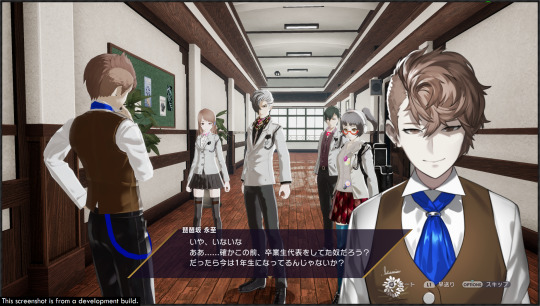
It’s even harder to escape comparisons to other high school life RPGs now, then it was at the time of its original release. Even if I’m not a fan of it, Persona 5’s shadow looms large over Caligula, since it explores similar themes and shares a history. Closer to Caligula’s scale, and maybe more relevant, Blue Reflection--Gust’s magical girl RPG--also released since then, which incorporates several similar ideas, but executes them more successfully. It’s hard not to look at the unique social media interactions and personal problems Blue Reflection gives to your schoolmates and see a better implementation of the generic, stock dialogue Caligula assigns to its high schoolers. It puts into perspective how thoughtless Caligula feels on that front.
I’m glad to see more games explore the space around modern day settings, and I’m all for more fake LINE interfaces where I can chat with friends. At the same time I can’t help but see that as a primary mode where The Caligula Effect Overdose falters. It can’t get by on the sheer novelty of the setting anymore, not with so many other notable players, and the story it tells nowhere near matches the ambition elsewhere.
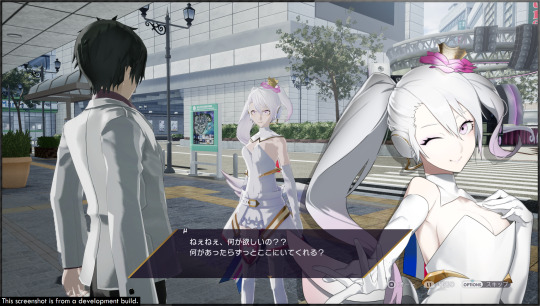
Worse, it’s genuinely ugly and cruel in places where it doesn’t feel justified, and which it never earns the right to be. Every social aspect of the game is riddled with narrative shortcuts, hoping to blast through the story fast enough and overwhelm you with a massive quantity so that you don’t notice that it’s not telling a story with any substance. Overdose makes it more tolerable, and highlights the more enjoyable aspects of the combat and artwork, but in doing so ends up bringing further into focus the other places Caligula is lacking.
1 note
·
View note